Chapter: Operations Research: An Introduction : Duality and Post-Optimal Analysis
Definition of the Dual Problem
DEFINITION
OF THE DUAL PROBLEM
The dual
problem is an LP defined directly and systematically from the primal (or original)
LP model. The two problems are so closely related that the optimal solution of
one problem automatically provides the optimal solution to the other.
In most
LP treatments, the dual is defined for various forms of the primal depending
on the sense of optimization (maximization or minimization), types of
constraints (≤,≥,=) and orientation of the variables (nonnegative or
unrestricted). This type of treatment is somewhat confusing, and for this
reason we offer a single definition
that automatically subsumes all forms
of the primal.
Our
definition of the dual problem requires expressing the primal problem in the equation form presented in Section 3.1
(all the constraints are equations with nonnegative right-hand side and all the
variables are nonnegative). This requirement is consistent with the format of
the simplex starting tableau. Hence, any results obtained from the primal
optimal solution will apply directly to the associated dual problem.
To show
how the dual problem is constructed, define the primal in equation form as follows:
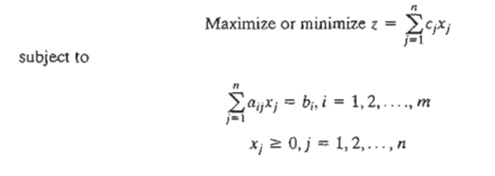
The
variables xj, j = 1,2, ...
, n, include the surplus, slack, and
artificial variables, if any. Table 4.1 shows how the dual problem is
constructed from the primal. Effectively,
we have
1. A dual variable
is defined for each primal (constraint) equation.
2. A dual
constraint is defined for each primal variable.
3. The
constraint (column) coefficients of a primal variable define the left-hand-side
coefficients of the dual constraint and its objective coefficient define the
right-hand side.
4. The
objective coefficients of the dual equal the right-hand side of the primal
con-straint equations.
TABLE 4.1 Construction of the Dual from the Primal
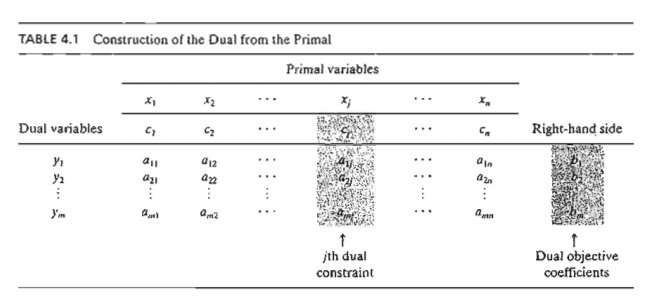

The rules
for determining the sense of optimization (maximization or minimization), the
type of the constraint( ≤, ≥, or =), and the sign of the dual variables are
summarized in Table 4.2. Note that the sense of optimization in the dual is
always opposite to that of the primal. An easy way to remember the constraint
type in the dual (i.e., ≤ or ≥) is that if the dual objective is minimization (i.e., pointing down), then the constraints are all of
the type ≥ (i.e., pointing up). The
opposite is true when the dual objective is maximization.
The
following examples demonstrate the use of the rules in Table 4.2 and also show
that our definition incorporates all forms of the primal automatically.
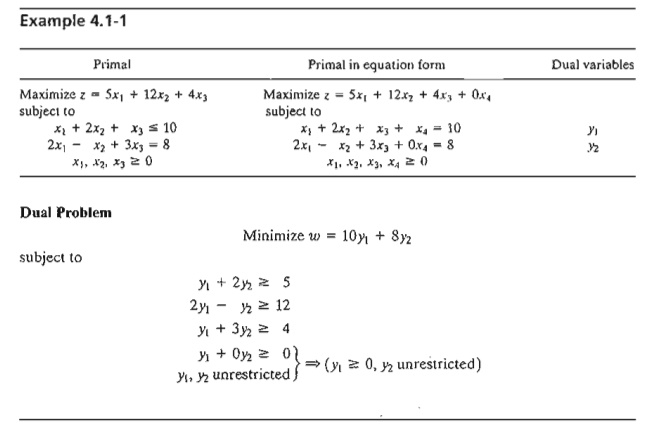

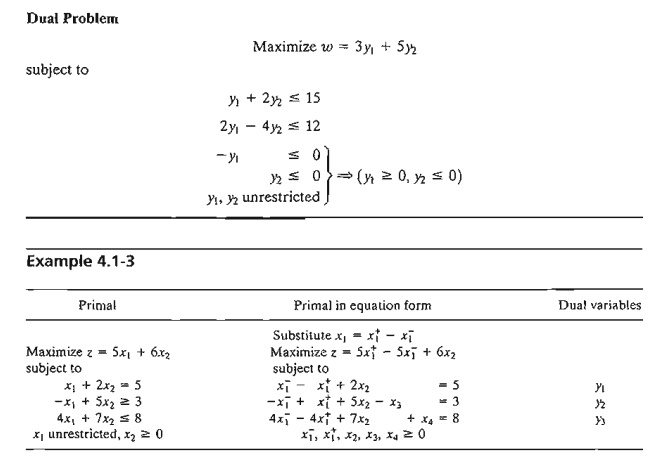
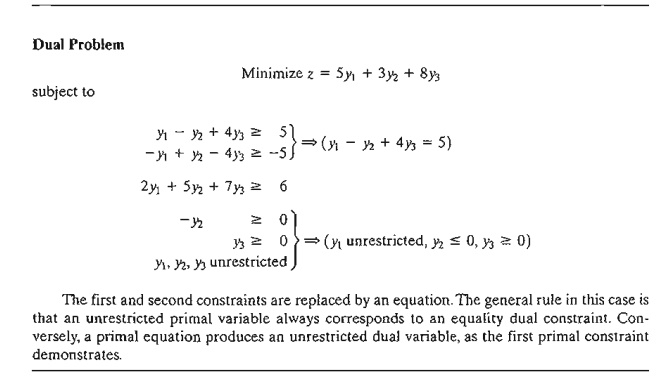
The first
and second constraints are replaced by an equation. The general rule in this
case is that an unrestricted primal variable always corresponds to an equality
dual constraint. Conversely, a primal equation produces an unrestricted dual
variable, as the first primal constraint demonstrates.
Summary of the Rules for Constructing the Dual. The
general conclusion from the preceding examples is that the variables and
constraints in the primal and dual problems are defined by the rules in Table
4.3. It is a good exercise to verify that these explicit rules are subsumed by
the general rules in Table 4.2.
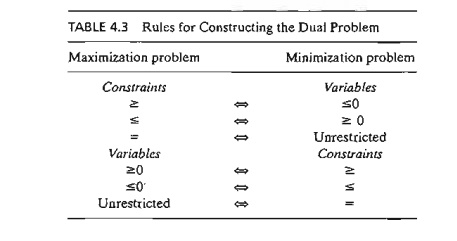
Note that
the table does not use the designation primal and dual. What matters here is
the sense of optimization. If the
primal is maximization, then the dual is minimization, and vice versa.
PROBLEM
SET 4.1A
1. In
Example 4.1-1, derive the associated dual problem if the sense of optimization
in the primal problem is changed to minimization.
*2. In Example 4.1-2, derive the associated dual
problem given that the primal problem is augmented with a third constraint, 3xl + x2 = 4.
3. In
Example 4.1-3, show that even if the sense of optimization in the primal is
changed to minimization, an unrestricted primal variable always corresponds to
an equality dual constraint.
4. Write
the dual for each of the following primal problems:

*5.
Consider Example 4.1-1. The application of the simplex method to the primal
requires the use of an artificial variable in the second constraint of the
standard primal to secure a starting basic solution. Show that the presence of
an artificial primal in equation form variable does not affect the definition
of the dual because it leads to a redundant dual constraint.
6. True
or False?
a. The dual of the dual problem yields the
original primal.
b. If the primal constraint is originally in
equation form, the corresponding dual vari-able is necessarily unrestricted.
c. If the primal constraint is of the type
≤, the corresponding dual variable will be non-negative (nonpositive) if the
primal objective is maximization (minimization).
d. If the primal constraint is of the type
≥, the corresponding dual variable will be non-negative (nonpositive) if the
primal objective is minimization (maximization).
e. An unrestricted primal variable will
result in an equality dual constraint.
Related Topics